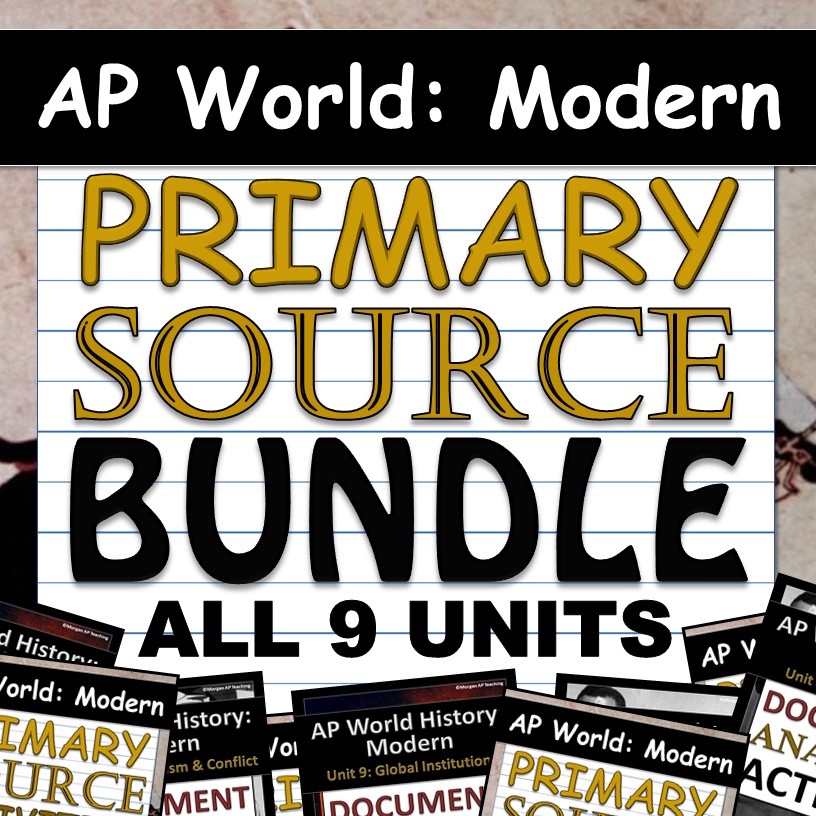
Click the Images Below to Preview!
Other Popular Products
AP World History: Modern -
Primary Source Analysis Bundle!
AP World Primary Source Bundle contains MORE THAN 75 PRIMARY SOURCE ACTIVITIES that cover ALL UNITS (1.1-9.8)! Google Drive access! Activities provide practice for AP Historical Thinking Skills 1.A, 2.A, 2.B, 2.C, 3.A, 3.C, 5.A, 5.B, 6.B, and 6.C! These are the historical skill activities I use with my students to achieve passing rates of over 90%!
I have added 60 NEW primary source activities to my original 16 that provide differentiated perspectives across all learning objectives for AP World.
The activities can be used as emergency sub print-and-go activities, in class for group or individual work, or assigned as homework for AP Test practice.
Bundle includes the following:
- An overview on how to use the resources
- Group and individual activity options!
- Answer keys to function as discussion guides
- Google Drive Access
- Lifelong access to all future updates!
- See the covered Unit Guide Learning Objectives for each below:
The 60 NEW Primary Source Activities
Unit 1: The Global Tapestry c. 1200 to c. 1450
- 1.1: Developments in East Asia from 1200 to 1450
- 1.2: Developments in Dar al-Islam from 1200 to 1450
- 1.3: Developments in Southeast Asia from 1200 to 1450
- 1.4: State Building in the Americas
- 1.5: State Building in Africa
- 1.6: Developments in Europe from c. 1200 to c. 1450
Unit 2: Networks of Exchange c. 1200 to c. 1450
- 2.1: The Silk Roads
- 2.2: The Mongol Empire and the Making of the Modern World
- 2.3: Exchange in the Indian Ocean
- 2.4: Trans-Saharan Trade Routes
- 2.5: Cultural Consequences of Connectivity
- 2.6: Environmental Consequences of Connectivity
Unit 3: Land-Based Empires c. 1450 to c. 1750
- 3.1 Empires Expand
- 3.2 Empires: Administration
- 3.3 Empires: Belief Systems
Unit 4: Transoceanic Interconnections c. 1450 to c. 1750
- 4.1: Technological Innovations from 1450 to 1750
- 4.2: Exploration: Causes and Events from 1450 to 1750
- 4.3: Columbian Exchange
- 4.4: Maritime Empires Established
- 4.5: Maritime Empires Maintained and Developed
- 4.6: Internal and External Challenges to State Power from 1450 to 1750
- 4.7: Changing Social Hierarchies from 1450 to 1750
Unit 5: Revolutions c. 1750 to c. 1900
- 5.1: The Enlightenment
- 5.2: Nationalism and Revolutions in the Period from 1750 to 1900
- 5.3: Industrial Revolution Begins
- 5.4: Industrialization Spreads in the Period from 1750 to 1900
- 5.5: Technology of the Industrial Age
- 5.6: Industrialization: Government’s Role from 1750 to 1900
- 5.7: Economic Developments and Innovations in the Industrial Age
- 5.8: Reactions to the Industrial Economy from 1750 to 1900
- 5.9: Society and the Industrial Age
Unit 6: Consequences of Industrialization c. 1750 to c. 1900
- 6.1: Rationales for Imperialism from 1750 to 1900
- 6.2: State Expansion from 1750 to 1900
- 6.3: Indigenous Responses to State Expansion from 1750 to 1900
- 6.4: Global Economic Development from 1750 to 1900
- 6.5: Economic Imperialism from 1750 to 1900
- 6.6: Causes of Migration in an Interconnected World
- 6.7: Effects of Migration
Unit 7: Global Conflict c. 1900 to the present
- 7.1: Shifting Power After 1900
- 7.2: Causes of World War I
- 7.3: Conducting World War I
- 7.4: Economy in the Interwar Period
- 7.5: Unresolved Tensions After World War I
- 7.6: Causes of World War II
- 7.7: Conducting World War II
- 7.8: Mass Atrocities After 1900
Unit 8: Cold War and Decolonization
- 8.1: Setting the Stage for the Cold War and Decolonization
- 8.2: The Cold War
- 8.3: Effects of the Cold War
- 8.4: Spread of Communism After 1900
- 8.5: Decolonization After 1900
- 8.6: Newly Independent States
- 8.7: Global Resistance to Established Power Structures After 1900
- 8.8: End of the Cold War
Unit 9: Globalization
- 9.1: Advances in Technology and Exchange After 1900
- 9.2: Technological Advances and Limitations After 1900: Disease
- 9.3: Technological Advances: Debates About the Environment After 1900
- 9.4: Economics in the Global Age
- 9.5: Calls for Reform and Responses After 1900
- 9.6: Globalized Culture After 1900
- 9.7: Resistance to Globalization After 1900
- 9.8: Institutions Developing in a Globalized World
The Original 16 Activities
Period 1
- 1.1: Developments in East Asia from 1200 to 1450
- 1.2: Developments in Dar al-Islam from 1200 to 1450
- 1.6: Developments in Europe from c. 1200 to c. 1450
- 2.5: Cultural Consequences of Connectivity
Period 2
- 3.2 Empires: Administration
- 4.4: Maritime Empires Established
- 4.5: Maritime Empires Maintained and Developed
- 4.7: Changing Social Hierarchies from 1450 to 1750
Period 3
- 5.2: Nationalism and Revolutions in the Period from 1750 to 1900
- 5.5: Technology of the Industrial Age
- 5.8: Reactions to the Industrial Economy from 1750 to 1900
- 6.1: Rationales for Imperialism from 1750 to 1900
Period 4
- 7.1: Shifting Power After 1900
- 8.2: The Cold War
- 8.3: Effects of the Cold War
- 9.8: Institutions Developing in a Globalized World



